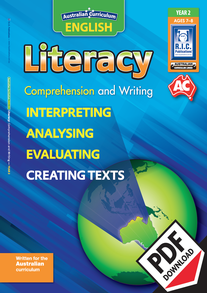$29.95
Comprehension text – Goorialla the rainbow serpent – Year 4 digital unit
Preview Book
- Format: Lesson plans and units
- Series: Australian Curriculum
- Code: RIC-30079
- Subject: English
- Level: Year 4
Price:
$2.00
Quantity:
This is a 7-page unit from the Developing Comprehension skills and word knowledge series that covers:
Text
- Understand how texts vary in complexity and technicality depending on the approach to the topic, the purpose and the intended audience (ACELA1490)
.png)
Comprehension
- Read different types of text by combing contextual, semantic, grammatical and phonic knowledge using text processing strategies for example monitoring meaning, cross checking and reviewing (ACELY1691)
.png)
- Use comprehension strategies to build literal and inferred meaning to expand content knowledge, integrating and linking ideas and analysing and evaluating texts (ACELY1692)
.png)
- Identify characteristic features used in imaginative, informative and persuasive texts to meet the purpose of the text (ACELY1690)
.png)
- Incorporate new vocabulary from a range of sources into students’ own texts including vocabulary encountered in research (ACELA1498)
.png)
- Recognise how quotation marks are used in texts to signal dialogue, titles and quoted (direct) speech (ACELA1492)
.png)
- Understand how adverb groups/phrases and prepositional phrases work in different ways to provide circumstantial details about an activity (ACELA1495)
.png)
Word knowledge
- Understand how to use phonic knowledge to read and write multisyllabic words with more complex letter combinations, including a variety of vowel sounds and known prefixes and suffixes (ACELA1828)
.png)
- Understand how to use knowledge of letter patterns including double letters, spelling generalisations, morphemic word families, common prefixes and suffixes and word origins to spell more complex words (ACELA1779)
.png)
Links to other curriuclum areas
Humanities and social sciences – History
- The diversity of Australia’s first peoples and the long and continous connection of Aboriginal and Torres Strait Islander peoples to Country/Place (land, sea, waterways and skies) (ACHASSK083)
.png)
Each individual text type covers a number of content descriptions across the Language, Literature and Literacy strands of Australian Curriculum English. The detailed lesson plans save valuable planning time and allow for individual student differences. Use all, or some, of the ideas provided to cater to the needs of your class.
**This ebook is not transferable, nor can it be on-sold or uploaded to an intranet site. For full copyright details, please see the Copyright Notice outlined in the ebook or refer to the Copyright Agency Limited www.copyright.com.au
No reviews have been added for this product yet.






















